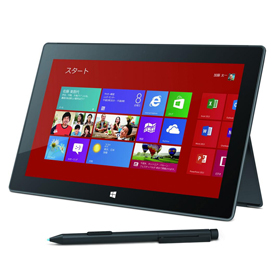 NEWS
NEWS
 NEWS
NEWS
 NEWS
NEWS
![]() Microsoft’s Surface Pro has had a somewhat muted reception since its US release, but that hasn’t stopped the Redmond from setting its sights on the rest of the world. Today, Microsoft has launched its flagship Windows 8 device in Japan, with the added bonus of up to 256GB of internal storage and a free copy of Microsoft Office.
Microsoft’s Surface Pro has had a somewhat muted reception since its US release, but that hasn’t stopped the Redmond from setting its sights on the rest of the world. Today, Microsoft has launched its flagship Windows 8 device in Japan, with the added bonus of up to 256GB of internal storage and a free copy of Microsoft Office.
By way of comparison, the US version of the Surface Pro offers a maximum 128GB of storage, while the Surface RT, which doesn’t run the full Windows 8 OS, comes with a mere 32GB or 64GB of storage, depending on how much you need. It’s interesting then that Microsoft has decided to add on a bigger hard drive with the Japanese version – for some reason it obviously thinks that this will tempt consumers in that country more than it will Americans. Of course we should note that people will only be able to use 208GB of that space, as the rest is taken up by the chunky Windows 8 OS and what we can only presume must be an array of pre-installed apps.
Aside from the bigger hard drive, the Surface Pro looks much the same as its US counterpart. The device comes with a 10.6-inch, 1920×1080 resolution touch screen, an Intel Core i5 processor and 4GB of RAM as standard. It’ll also be priced similarly at around 99,800 yen, or about $980, when it hits the stores on June 7.
At least for that price they’ll get a copy of Office bundled in for free, which is something else that the US version doesn’t have – this inclusion alone may tempt many buyers who are still committed to using Microsoft’s productivity software.
The Japanese model is part of a wider roll-out of the Microsoft Surface, which will be on sale in 27 countries by the end of June.
We’ll be interested to see how well the Surface Pro is received in Japan and elsewhere. To date, Microsoft has struggled to shift its hardware – many consumers feel that the device is too expensive for a tablet, while others don’t even consider it to be a tablet anyway – if anything, it’s somewhere in the middle, being too bulky to be considered a real tablet, yet too lightweight to be a real laptop, a state of affairs that’s probably caused a lot of people to consider buying something else.
There have been other criticisms too. For one thing, many have complained about the flexible keyboard, saying that its uncomfortable to type on, especially when the device is sat there on your lap.
Of course, Microsoft hasn’t made any official announcement about how many devices its sold, but that silence has only increased speculation that it isn’t doing as well as the company had hoped.
THANK YOU